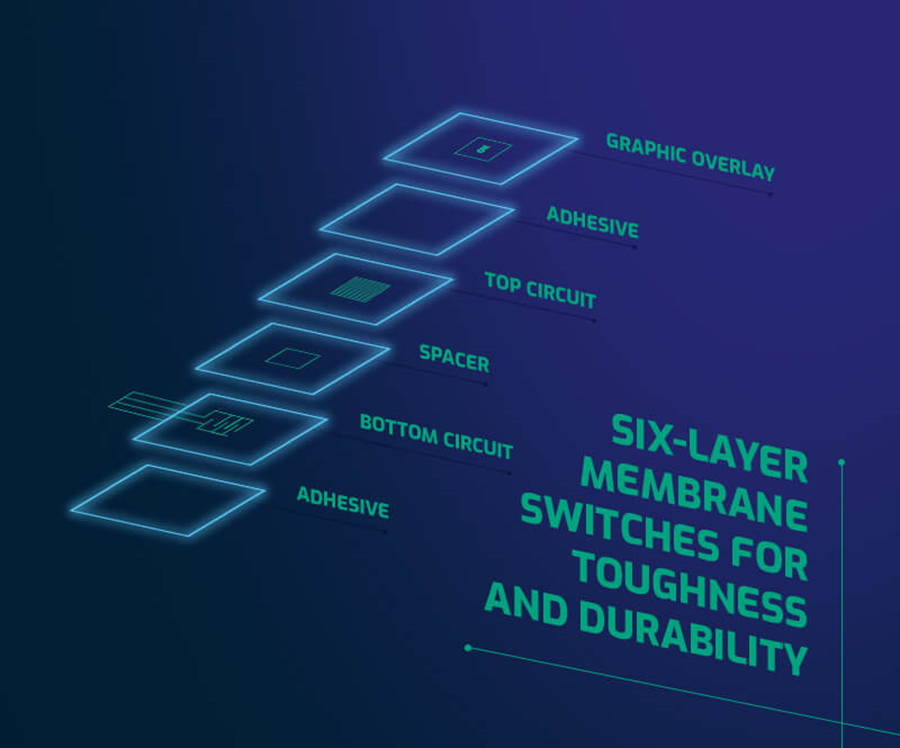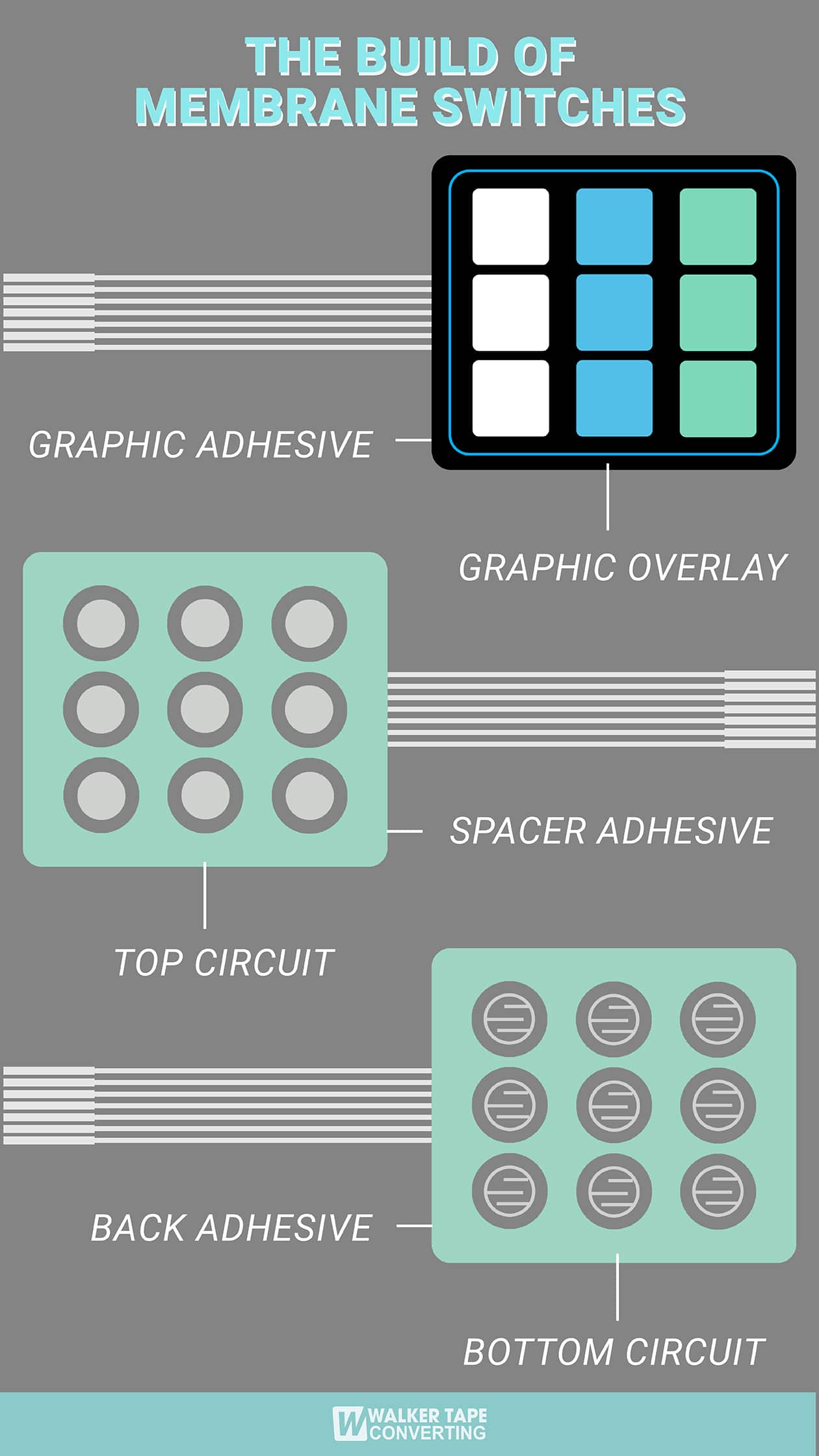The Manufacturing Process Behind Membrane Layer Change: What You Need to Know
The manufacturing process behind membrane layer changes combines mindful layout, product choice, and quality assurance. It begins with comprehending the complexities of membrane layer switch design and proceeds with different stages, including product choices and printing methods. Each stage plays an important duty in making certain capability and resilience. The intricacies of layer building and construction and the strenuous testing criteria might expose insights that are not right away noticeable. What lies past these fundamental elements?
Comprehending Membrane Switch Over Style
Membrane layer switches may appear straightforward at initial look, their style involves complex considerations that assure performance and toughness. The style process starts with a thorough understanding of individual needs, including the user interface's desired application and environmental elements. Functional designs is a crucial element, as the layout should facilitate convenience of use while making certain that tactile feedback meets individual expectations.Moreover, the layering of components, such as graphic overlays, sticky layers, and conductive traces, need to be exactly engineered. membrane switch. This layered arrangement not only influences the button's responsiveness but additionally impacts its durability. Interest is provided to the sealing techniques employed to protect versus wetness and dust, which might endanger efficiency. Furthermore, design factors to consider include appearances, where color design and aesthetic quality boost user experience. Ultimately, the design of membrane layer switches balances capability, user experience, and resilience, making sure that they meet the demands of different applications properly
Products Made Use Of in Membrane Change Manufacturing
When choosing products for membrane layer switch production, it is important to ponder both efficiency and resilience. The key products include polyester and polycarbonate films, which supply adaptability and stamina. These movies are often covered with adhesive to guarantee proper bonding to substratums. Conductive inks, commonly composed of silver or carbon, are important for creating electrical connections within the button, enabling for dependable operation.Additionally, a safety layer, such as a difficult coat, is regularly put on improve scrape resistance and longevity. The selection of backing material, such as acrylic or foam, can considerably affect the switch's tactile feel and total customer experience. Various ecological variables, including temperature level and humidity, should guide product selection to assure peak performance in particular applications. Eventually, the ideal mix of products contributes to the membrane button's capability and life expectancy, making educated choices necessary for suppliers.
The Printing Process: Creating Video and Text
The printing process in membrane layer switch production plays a significant function in generating high-quality graphics and text. Numerous visuals design strategies are utilized to guarantee aesthetic allure and functionality, while mindful ink selection techniques are crucial for sturdiness and performance. Comprehending these aspects is essential for attaining finest lead to membrane layer button layout.
Graphic Design Techniques
Graphic design strategies play a vital function in the printing procedure of membrane buttons, as they specify exactly how graphics and message will ultimately show up on the end product. Effective graphic style involves the tactical use shades, fonts, and layouts to improve readability and visual charm. Developers usually make use of vector graphics for scalability, making sure that pictures remain sharp at numerous dimensions. Furthermore, focus to contrast and positioning is important, as it influences individual interaction and visual top quality. The unification of branding aspects, such as logo designs, need to be taken care of with treatment to preserve brand honesty. Generally, thoughtful graphic layout strategies add substantially to the functionality and good looks of membrane layer buttons, influencing user experience and product performance.
Ink Selection Methods
Picking the suitable ink is necessary for accomplishing the wanted aesthetic high quality and sturdiness in membrane switch manufacturing. Numerous ink types are utilized, including solvent-based, water-based, and UV-curable inks. Each type uses distinctive features, such as resistance, adaptability, and attachment to ecological variables. Solvent-based inks are typically preferred for their toughness and vivid colors, while water-based inks are a lot more ecologically friendly however might have restrictions in attachment. UV-curable inks offer quick healing and robust efficiency. In addition, shade matching techniques guarantee that the selected inks line up with layout specifications. Inevitably, the choice of ink should think about factors such as application approach, substrate compatibility, and end-use requirements to attain exceptional outcomes in membrane layer switch graphics and text.
Layer Building and Setting Up

Material Selection Refine
A mindful selection of products is vital in the production process of membrane layer buttons, as it directly influences capability and toughness. The primary materials used consist of polyester, polycarbonate, and various conductive inks. Polyester is commonly preferred for its outstanding resistance to chemicals and abrasion, making it appropriate for rough settings. Polycarbonate, on the other hand, provides premium clarity and impact resistance, which is advantageous for applications needing visibility and toughness. Conductive inks, generally composed of silver or carbon, are essential for developing trustworthy over at this website electrical pathways. Additionally, the choice of adhesive products affects the general integrity of the button - membrane switch. Reviewing variables such as ecological exposure, tactile responses, and visual demands overviews makers in choosing the most effective materials for their details applications
Layer Bond Methods
Adhering layers in membrane layer switch construction is a crucial procedure that ensures functionality and longevity. Numerous adhesion methods are utilized to safeguard ideal bonding between layers, which generally consist of the usage of adhesives, heat, and stress. Pressure-sensitive adhesives (PSAs) are generally used for their simplicity of application and immediate bonding capacities. Additionally, thermal bonding methods can be applied, where heat is utilized to trigger glue buildings, safeguarding a solid bond. The option of attachment technique greatly depends upon the click site materials included and the particular application needs of the membrane switch. Appropriate placement and consistent application of adhesives are vital to avoid defects, safeguarding the switch runs efficiently throughout its designated life expectancy.
Quality Assurance Measures
Assuring top quality control throughout the layer building and setting up of membrane switches is crucial for preserving efficiency and dependability. This procedure typically involves numerous crucial measures, including complete examinations at each stage of production. Manufacturers make use of innovative screening techniques, such as peel tests and bond analyses, to validate the integrity of layer bonds. In addition, aesthetic inspections are performed to identify any kind of issues in printing or material inconsistencies. Environmental problems, such as temperature level and moisture, are carefully monitored to ensure optimal curing and adhesion. Routine calibration of devices helps keep accurate manufacturing criteria. By implementing these high quality control steps, makers can greatly reduce the risk of product failing, ensuring that the last membrane switches over fulfill the required specifications and customer expectations.
Checking and Quality Assurance Procedures

Technologies in Membrane Layer Switch Innovation
As advancements in technology continue to advance, membrane buttons are benefiting from innovative growths that enhance their performance and user experience. One noteworthy technology is the integration of capacitive touch innovation, which enables more intuitive and responsive customer interfaces. This shift not only boosts aesthetic appeals yet likewise reduces mechanical wear and tear, prolonging the life-span of the switches.Additionally, improvements in graphic overlay products have actually resulted in boosted sturdiness and resistance to ecological factors such as wetness and UV light. These products now provide boosted clearness and illumination, further raising the aesthetic appeal.Furthermore, the incorporation of wise modern technology is changing membrane changes right into interactive control board, enabling connectivity with IoT gadgets. This connection fosters a seamless individual experience, leading the means for applications in various industries, from health care to customer electronic devices. Jointly, these innovations position membrane changes as essential components in modern device style.
Often Asked Concerns
Just how Lengthy Does the Membrane Layer Switch Over Production Process Take?
The period of the membrane layer button production procedure can differ substantially. Factors such as complexity, products made use of, and manufacturing quantity impact timelines, with regular manufacturing varying from a couple of days to a number of weeks for conclusion.
What Are the Typical Applications for Membrane Switches?
Membrane switches are commonly utilized in numerous sectors, consisting of vehicle controls, family home appliances, medical devices, and consumer electronic devices (membrane switch). Their convenience and durability make them ideal for applications calling for straightforward user interfaces and reputable performance in diverse settings
Can Membrane Layer Changes Be Customized for Specific Demands?

What Is the Life expectancy of a Normal Membrane Layer Switch Over?
The lifespan of a common membrane switch varies, however typically, it ranges from 1 to 5 million cycles. Variables such as usage, atmosphere, and material top quality greatly my link affect resilience and overall performance with time.

Are Membrane Changes Ecologically Friendly?
The ecological kindness of membrane layer switches varies. Some products used may not be recyclable, while others can be eco-friendly. The total effect depends upon manufacturing products and methods, requiring careful factor to consider during selection and disposal. The production procedure behind membrane switches over combines cautious design, product choice, and quality control. It starts with comprehending the intricacies of membrane button layout and advances through numerous stages, consisting of material selections and printing methods. When selecting products for membrane button manufacturing, it is crucial to consider both performance and toughness. A careful option of materials is essential in the manufacturing procedure of membrane buttons, as it directly affects functionality and toughness. The choice of bond method mainly depends on the products included and the details application requirements of the membrane layer button.